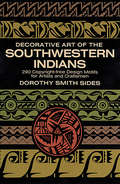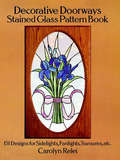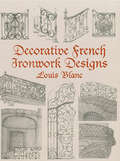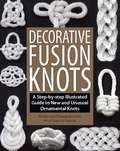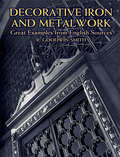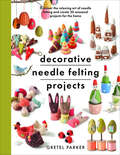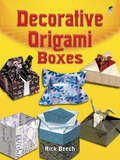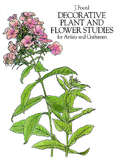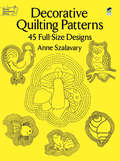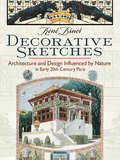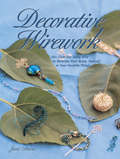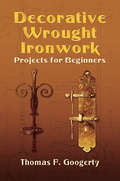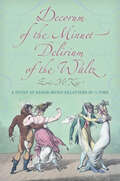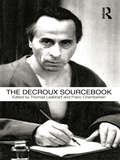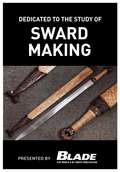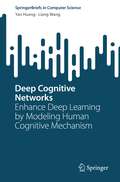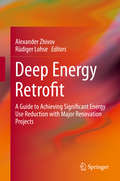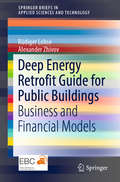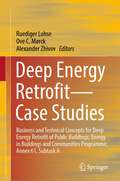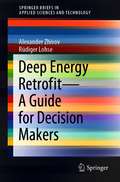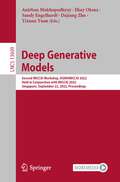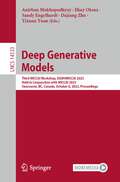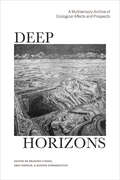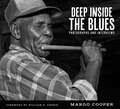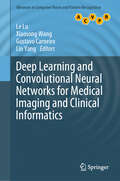- Table View
- List View
Decorative Art of the Southwestern Indians
by Dorothy S. SidesThe decorative art of the Indians of the American Southwest has long been recognized as one of the most beautiful art traditions in the primitive world. It demonstrates a technical skill with simple materials, a symbolic richness, and a faculty for creating rich effects by the imaginative use of ornament that are all almost unique. Museums use Pueblo ceramics for display pieces, and modern artists and crafters have turned eagerly to the handwork of prehistoric Indian women for inspiration and working ideas.Mrs. Dorothy Sides, a noted artist and collector, has gathered together and redrawn in black and white nearly 300 examples of the finest authentic Southwestern Indian decoration that she has seen in a lifetime of study. She has not limited her selection to one period or style, however; to make her book as useful as possible, she has selected material ranging from the thirteenth century great geometric art of the Pueblos to the handcrafts carried on by the nomadic and Pueblo peoples of the present.The main emphasis of this volume is on ceramic decoration, and Mrs. Sides includes pieces from the rich archeological sites of Pecos, Sikyatki, the Mimbres, and modern Pueblo pottery from Acoma, Zuni, Cochiti, and the Hopi. She also includes designs and motifs from the basketry of the Apache, Pima, and Papago; beadwork from the Mohave; authentic Zuni masks; Hopi kachina dolls; and sand paintings and blanket designs from the Navajo. This broad coverage of beautiful ornament illustrates many different art styles to fit every situation: geometric designs based upon balanced mirror fields of design, symbolic figures of the thunderbird, and modern stylizations. All is beautiful and imaginative.Any crafter working with ceramics will find this book indispensable as a source of rich, easily used, powerful design; workers in wood, weavers, metal workers, and leather workers will find that it will enlarge their decorative resources considerably. It also offers unusual and eye-catching designs for commercial artists who wish to do work suggesting travel, handcrafts, the Southwest, or the social sciences. Individual drawings are royalty-free and may be reproduced without fee or permission.
Decorative Doorways Stained Glass Pattern Book: 151 Designs for Sidelights, Fanlights, Transoms, etc.
by Carolyn ReleiThrough the centuries, stained glass designs have been used to decorate doorways and entries and to add to these essential architectural features a welcoming aura of beauty and light. Stained glass artist Carolyn Relei has created scores of elegant but simple designs for sidelights, fanlights, and transoms easily adaptable to the many different architectural and decorating styles popular today. Over 150 of her most beautiful designs are presented in this superb stained glass pattern book.The patterns, easily adaptable as templates, depict a wide variety of subjects, from trellised roses, soaring birds, and bouquets of tulips to geometric and abstract designs. Most of the shapes are elongated rectangles, ideal for transoms and sidelights, but Ms. Relei has added many beautiful half-circle fanlight designs and such popular stained glass shapes as the oval and circle to complete this outstanding collection. In addition to stained glass work, these lovely royalty-free designs have applications to many other art and craft projects.
Decorative French Ironwork Designs
by Louis BlancAntique lovers, architecture buffs, and graphic artists will treasure this magnificent collection of decorative French ironwork designs -- all of them authentic examples from the celebrated ornamental ironwork of Bordeaux. Over 1,500 handsome black-and-white illustrations depict painstakingly rendered balconies, gates, grilles, stair railings, doorknobs, and doorknockers.Meticulously reproduced with extraordinary clarity and remarkable detail, these elegant images are derived from a rare early twentieth-century volume privately printed in Paris. They incorporate floral and foliate designs, human and animal figures, musical motifs, heraldic crests, mythological figures, geometrics, and much more.A vibrant source of inspiration and royalty-free graphics, this collection offers artists and designers an affordable treasury of material that will bring period flair and decorative dazzle to a wide variety of art and craft projects.
Decorative Fusion Knots
by Barry Mault J. D. LenzenThe future of decorative knots has arrived!JD, the producer of over 100 instructional knot videos and the creator of the famed YouTube channel "Tying It All Together," reveals his innovative knotting style in Decorative Fusion Knots: A Step-by-Step, Illustrated Guide to Unique and Unusual Ornamental Knots.Respected internationally for his knotting skills and clear, concise video and book presentations, JD shows how to tie knots like no others. Just as origami figurines are created through the merging of different folding techniques, JD creates new knots by combining historical knot elements and new knotting techniques. The products of this intermingling are what he calls fusion knots - a brand new genre of knot in a centuries-old tradition. It is rare for a knot book to feature even one brand new, never-before-seen knot, but Decorative Fusion Knots features more than 25 brand new knots created by the author.Decorative Fusion Knots is the culmination of 10 years of study, practice and creation. The knots within were inspired by history, nature, mythology, and more. Many of these incredible knots have never been presented or described publicly, until now. Never before has a knot book presented a step-by-step format to tying brand new knots like this in full-color.Alongside fusion knots, JD presents logical and comprehensive instructions for a plethora of historical knots, including Celtic knots, Chinese decorative knots, maritime knots, and popular paracord ties. Each historical knot instruction is presented in step-by-step fashion with full-color photographs. In fact, over 300 step-by-step color photographs are included in the book, each accompanied with clear, concise instructional captions.Whether you're a sailor, teacher, jewelry maker, survivalist, general knot enthusiast, or just looking for bush crafts, paracord ties, a curriculum for students, or a fun way to pass the time, Decorative Fusion Knots is the book for you. With easy-to-understand captions and clear step-by-step photos, readers can learn at their own pace, review whole techniques at a single glance and simply lay the book flat on the table and follow along as they tie.
Decorative Iron and Metalwork: Great Examples from English Sources
by R. Goodwin-SmithMagnificent study by expert on age-old craft provides a spirited overview. 140 illustrations include grilles, doors, and gates; stair railings and balustrades; small handles, hinges, door-knockers, and keyhole plates; Elizabethan-era firedogs; weather vanes; much more, many never catalogued before. Rich source of inspiration, royalty-free graphics, information.
Decorative Needle Felting Projects: Discover the Relaxing Art of Needle Felting and Create 20 Seasonal Projects for the Home (Crafts Ser.)
by Gretel ParkerNeedle felting is the simple process of transforming wool into 3D objects using a barbed needle. It’s a fun craft that is easy to learn and gets amazing results. With just a few basic tools and simple step by steps, you'll be on your way to making your own adorable felted creations. In this beautifully designed book, discover the relaxing craft of needle felting and learn how to make delightful creations to use and wear. Following the basic method, many of the patterns can be resized and with the addition of techniques such as darning, patching and stitching, the home crafter can adapt each design to make their very own creations. Including clear step-by-step photos and concise instructions, the patterns are easy to follow, even for complete beginners. No previous needle felting experience is needed. All projects are designed to appeal to a broad base of crafters who will enjoy the added mixed media interest and the opportunity to take a basic pattern and develop it to suit their own needs. The projects range from the quick and easy, such as small Easter Egg Dangles, to the more complex, such as a Winter Gingerbread Village. Wearable designs include an Autumn Fox Bangle and a Midsummer Rose Corsage. This new and innovative approach to needle felting widens the creative possibilities beyond the core twenty patterns so the maker can choose to flex their creative wings and discover new approaches to the craft.
Decorative Origami Boxes
by Rick BeechForget the giftwrap--these unique boxes are perfect for gift-giving. In fact, they're handmade gifts all by themselves! Choose your own paper, and make a keepsake treasure--or make dozens! Step-by-step diagrams make it easy to create a work of art.A well-known British origami expert, Rick Beech is the author of several books. These unusual and imaginative designs appeal to paperfolders at every level of experience. This book features fifteen different patterns for boxes, along with some lid variations and decorative accents, offering a useful, affordable way to expand your origami repertoire.
Decorative Plant and Flower Studies: For Artists and Craftsmen
by J. Foord88 royalty-free drawings of 40 plants and flowers -- Daffodil, Apple and other more or less familiar species -- distinguished by their grace, impeccable draftsmanship, and botanical accuracy. Extensive texts include botanical history, peculiar characteristics, folklore, poetic renderings, and more. An artist's sourcebook imbued with the spirit of poetry!
Decorative Quilting Patterns: 45 Full-Size Designs
by Anne SzalavaryThis unique book introduces 45 full-sized decorative stitching designs for quilts in an exciting variety of motifs. They range from plant and animal life to abstract designs, and include such appealing subjects as a beautiful seashell, a tempting bunch of grapes, a regal blue jay, and a smiling frog -- all ready to add a charming touch to any quilt.In addition to the full-size designs, the book includes detailed instructions that will enable even beginning quilt stitchers to achieve perfect results.
Decorative Sketches: Architecture and Design Influenced by Nature in Early 20th-Century Paris
by René BinetAt the turn of the 20th century, artists and craftsmen throughout Europe and America were profoundly affected by a new art style that took its inspiration from nature. Generally referred to as Art Nouveau, the trend influenced all manner of creative types, from painters, illustrators, and architects to ironworkers, interior decorators, and designers of furniture and jewelry. Although broad and varied, the style is almost uniformly characterized by abstract, asymmetrical, curvilinear design. This "new art" both elevated the status of crafts to fine arts and brought objects into a harmonious relationship with their environment through the use of lines that were natural, vital, and, most importantly, organic.The decorative images in this volume, reproduced from a rare 1902 portfolio, reflect the era's exotic and imaginative approach to architecture and applied design. Sixty plates, 12 in full color and many with partial and varied color, exhibit the influence of the artwork of naturalist Ernst Haeckel on artist René Binet's designs, especially as related to Binet's "Monumental Door," prepared for the 1900 World's Fair in Paris. Illustrations reflecting the styles of Art Nouveau include a wealth of examples that range from doorbells and keys to stairways, fountains, jewelry, ceramics, and other items. Graphic designers, illustrators, architects, artists, and crafters will find this volume a rich source of ornamental ideas, authentic motifs, and design inspiration.
Decorative Wirework: 50+ Ideas For Using Wire to Decorate Your Home, Yourserlf, or Your Favorite Thin gs
by Jane DavisWith more than 50 projects to choose from, this is a great idea book for the beginning to advanced wirework enthusiast. Readers will find fresh, creative ideas for using wire, as well as clear instructions for basic elements in wire design. Author Jane Davis begins with simple projects, such as an open spiral bracelet, and then progresses to more advanced variations by adding beads and construction details for more elaborate projects, like a hinged box with ornate decorative elements. She demonstrates everything from loops and clasps to hinges and cages so readers can make brooches, bracelets, earrings, ornaments, candleholders, and window treatments. More than 100 photos and illustrations guide the reader through this must-have wire project and idea book.
Decorative Wrought Ironwork: Projects For Beginners (Dover Craft Books)
by Thomas F. GoogertyAn excellent introduction to the exciting world of ironwork, this easy-to-follow guide features dozens of simple, traditional plans for use by amateur craftspeople and students interested in metalworking. Articles in the collection have been selected for their simplicity, but some previous experience in at least a few of the more common, basic processes employed in forging metals is recommended.The manual contains everything metalsmiths and hobbyists could wish for, including precisely drawn-to-scale patterns, descriptive notes on the tools of the trade, and detailed instructions on the metalworking process. More than 45 illustrations provide clearly drawn designs for flowerpot holders and stands, ash trays, andirons, candlesticks, door latches and locks, hinges, lamps, door knockers, and other decorative domestic accessories. A rich source of information and inspiration, Decorative Wrought Ironwork Projects for Beginners invites hobbyists to choose from a remarkable variety of motifs that can be successfully fashioned with the help of working drawings and helpful notes on construction.
Decorum of the Minuet, Delirium of the Waltz: A Study of Dance-Music Relations in 3/4 Time
by Eric J. MckeeMuch music was written for the two most important dances of the 18th and 19th centuries, the minuet and the waltz. In Decorum of the Minuet, Delirium of the Waltz, Eric McKee argues that to better understand the musical structures and expressive meanings of this dance music, one must be aware of the social contexts and bodily rhythms of the social dances upon which it is based. McKee approaches dance music as a component of a multimedia art form that involves the interaction of physical motion, music, architecture, and dress. Moreover, the activity of attending a ball involves a dynamic network of modalities--sight, sound, bodily awareness, touch, and smell, which can be experienced from the perspectives of a dancer, a spectator, or a musician. McKee considers dance music within a larger system of signifiers and points-of-view that opens new avenues of interpretation.
The Decroux Sourcebook
by Franc Chamberlain Thomas LeabhartThe Decroux Sourcebook is the first point of reference for any student of the ‘hidden master’ of twentieth century theatre. This book collates a wealth of key material on Etienne Decroux, including: an English translation of Patrice Pezin’s ‘Imaginary Interview’, in which Decroux discusses mime’s place in the theatre. previously unpublished articles by Decroux from France’s Bibiothèque Nationale. essays from Decroux’s fellow innovators Eugenio Barba and Edward Gordon Craig, explaining the synthesis of theory and practice in his work. Etienne Decroux’s pioneering work in physical theatre is here richly illustrated not only by a library of source material, but also with a gallery of images following his life, work and influences. The Decroux Sourcebook is an ideal companion to Thomas Leabhart’s Etienne Decroux in the Routledge Performance Practitioners series, offering key primary and secondary resources to those conducting research at all levels.
Dedicated to the Study of Sword Making
by Joe KertzmanLet author Don Fogg help you build of one of the big blades, the lengthy lopper - the sword! His step-by-step sword-making process resonates well with enthusiasts who can't get enough of the romance, history, look, feel, usefulness, ethnic heritage and physical impressiveness of swords.
Deep Cognitive Networks: Enhance Deep Learning by Modeling Human Cognitive Mechanism (SpringerBriefs in Computer Science)
by Yan Huang Liang WangAlthough deep learning models have achieved great progress in vision, speech, language, planning, control, and many other areas, there still exists a large performance gap between deep learning models and the human cognitive system. Many researchers argue that one of the major reasons accounting for the performance gap is that deep learning models and the human cognitive system process visual information in very different ways. To mimic the performance gap, since 2014, there has been a trend to model various cognitive mechanisms from cognitive neuroscience, e.g., attention, memory, reasoning, and decision, based on deep learning models. This book unifies these new kinds of deep learning models and calls them deep cognitive networks, which model various human cognitive mechanisms based on deep learning models. As a result, various cognitive functions are implemented, e.g., selective extraction, knowledge reuse, and problem solving, for more effective information processing. This book first summarizes existing evidence of human cognitive mechanism modeling from cognitive psychology and proposes a general framework of deep cognitive networks that jointly considers multiple cognitive mechanisms. Then, it analyzes related works and focuses primarily but not exclusively, on the taxonomy of four key cognitive mechanisms (i.e., attention, memory, reasoning, and decision) surrounding deep cognitive networks. Finally, this book studies two representative cases of applying deep cognitive networks to the task of image-text matching and discusses important future directions.
Deep Energy Retrofit: A Guide to Achieving Significant Energy Use Reduction with Major Renovation Projects (Springerbriefs In Applied Sciences And Technology Ser.)
by Alexander Zhivov Rüdiger LohseThis book provides detailed information on how to set up Deep Energy Retrofits (DERs) in public buildings, and shares in-depth insights into the current status of the major technologies, strategies and best practice examples of how to cost-effectively combine them. Case studies from the U.S.A. and Europe show that that Deep Energy Retrofit can be achieved with a limited core technologies bundle readily available on the market. Characteristics of some of these core technology measures depend on the technologies available on an individual nation’s market, on the minimum requirements of national standards, and on economics (as determined by a life cycle cost analysis). Also, requirements to building envelope-related technologies (e.g., insulation levels, windows, vapor and water barriers, and requirements for building airtightness) depend on specific climate conditions. This Guide provides best practice examples of how to apply these technologies in different construction situations.High levels of energy use reduction using core technology bundles along with improvements in indoor climate and thermal comfort can be only achieved when a Deep Energy Retrofit adopts a quality assurance process. In addition to design, construction, commissioning, and post-occupancy phases of the quality assurance process, the Guide emphasizes the importance of clearly and concisely formulating and documenting the Owner’s goals, expectations, and requirements for the renovated building during development of the statement of work. Another important component of the quality assurance process is a procurement phase, during which bidders’ qualifications, their understanding of the scope of work and its requirements, and their previous experience are analyzed.The building sector holds the potential for tremendous improvements in terms of energy efficiency and reducing carbon emissions, and energy retrofits to the existing building stock represent a significant opportunity in the transition to a low-carbon future. Moreover, investing in highly efficient building materials and systems can replace long-term energy imports, contribute to cost cutting, and create a wealth of new jobs. Yet, while the technologies needed in order to improve energy efficiency are readily available, significant progress has not yet been made, and “best practices” for implementing building technologies and renewable energy sources are still relegated to small “niche” applications.Offering essential information on Deep Energy Retrofits, the book offers a valuable asset for architects, public authorities, project developers, and engineers alike.
Deep Energy Retrofit Guide for Public Buildings: Business and Financial Models (SpringerBriefs in Applied Sciences and Technology)
by Rüdiger Lohse Alexander ZhivovThis book provides detailed information on how to set up Deep Energy Retrofits (DERs) in public buildings, and shares in-depth insights into the current status of the major technologies, strategies and practical best practice examples of how to cost-effectively combine them. Case studies from Europe are analyzed with respect to energy use before and after renovation, reasons for undertaking the renovation, co-benefits achieved, resulting cost-effectiveness, and the business models employed. The building sector holds the potential for tremendous improvements in terms of energy efficiency and reducing carbon emissions, and energy retrofits to the existing building stock represent a significant opportunity in the transition to a low-carbon future. Moreover, investing in highly efficient building materials and systems can replace long-term energy imports, contribute to cost cutting, and create a wealth of new jobs. Yet, while the technologies needed in order to improve energy efficiency are readily available, significant progress has not yet been made, and “best practices” for implementing building technologies and renewable energy sources are still relegated to small “niche” applications. Offering essential information on Deep Energy Retrofits, the book offers a valuable asset for architects, public authorities, project developers, and engineers alike.
Deep Energy Retrofit—Case Studies: Business and Technical Concepts for Deep Energy Retrofit of Public Buildings; Energy in Buildings and Communities Programme; Annex 61, Subtask A
by Ruediger Lohse Ove C. Mørck Alexander ZhivovThis book describes results of research conducted with the goal of providing a framework, selected tools, and guidelines to significantly reduce energy use (by more than 50%) in government and public buildings. The scope of the book is limited to public buildings that were constructed before the 1980s with low internal loads (e.g., office buildings, dormitories, barracks, public housing, and educational buildings) and that were undergoing major renovation. The book contains description and analysis of 26 well-documented case studies from Europe (Austria, Denmark, Estonia, Germany, Ireland, Latvia, Montenegro, The Netherlands, and the UK) and the USA. After these data were collected, the case studies were analyzed with respect to energy use (before and after renovation), reasons for undertaking the renovation, co-benefits achieved, resulting cost-effectiveness, and the business models followed. Finally, “lessons learned” were compiled and compared.Deep Energy Retrofit (DER) is a major building renovation project in which site energy use intensity (including plug loads) has been reduced by at least 50% from the pre-renovation baseline with a corresponding improvement in indoor environmental quality and comfort. Lessons learned from the case studies and experiences of the team clearly indicate that DER can be achieved with the application of “bundles” of a limited number of core technologies readily available on the market. Specific characteristics of some of these core technology bundles generally depend on the technologies available on an individual nation’s market, on the minimum requirements of national standards, and on economics (as determined by a life cycle cost [LCC] analysis).
Deep Energy Retrofit—A Guide for Decision Makers (SpringerBriefs in Applied Sciences and Technology)
by Alexander Zhivov Rüdiger LohseMany governments worldwide are setting more stringent targets for reductions in energy use in government/public buildings. Buildings constructed more than 10 years ago account for a major share of energy used by the building stock. However, the funding and “know-how” (applied knowledge) available for owner-directed energy retrofit projects has not kept pace with new requirements. With typical retrofit projects, reduction of energy use varies between 10 and 20%, while actual executed renovation projects show that energy use reduction can exceed 50%, and can cost-effectively achieve the Passive House standard or even approach net zero-energy status (EBC Annex 61 2017a, Hermelink and Müller 2010; NBI 2014; RICS 2013; Shonder and Nasseri 2015; Miller and Higgins 2015; Emmerich et al. 2011).Building energy efficiency (EE) ranks first in approaches with resource efficiency potential with a total resource benefit of approximately $700 billion until 2030. EE is by far the cheapest way to cut CO2 emissions (McKinsey 2011, IPCC 2007). However, according to an IEA study (IEA 2014a), more than 80% of savings potential in building sector remains untapped. Thus, the share of deployed EE in the building sector is lower than in the Industry, Transport, and Energy generation sectors. Estimates for the deep renovation potentials show: €600-900bn investment potential, €1000-1300bn savings potential, 70% energy-saving potential, and 90% CO2 reduction potential.
Deep Generative Models: Second MICCAI Workshop, DGM4MICCAI 2022, Held in Conjunction with MICCAI 2022, Singapore, September 22, 2022, Proceedings (Lecture Notes in Computer Science #13609)
by Anirban Mukhopadhyay Ilkay Oksuz Sandy Engelhardt Dajiang Zhu Yixuan YuanThis book constitutes the refereed proceedings of the Second MICCAI Workshop on Deep Generative Models, DG4MICCAI 2022, held in conjunction with MICCAI 2022, in September 2022. The workshops took place in Singapore. DG4MICCAI 2022 accepted 12 papers from the 15 submissions received. The workshop focusses on recent algorithmic developments, new results, and promising future directions in Deep Generative Models. Deep generative models such as Generative Adversarial Network (GAN) and Variational Auto-Encoder (VAE) are currently receiving widespread attention from not only the computer vision and machine learning communities, but also in the MIC and CAI community.
Deep Generative Models: Third MICCAI Workshop, DGM4MICCAI 2023, Held in Conjunction with MICCAI 2023, Vancouver, BC, Canada, October 8, 2023, Proceedings (Lecture Notes in Computer Science #14533)
by Anirban Mukhopadhyay Ilkay Oksuz Sandy Engelhardt Dajiang Zhu Yixuan YuanThis LNCS conference volume constitutes the proceedings of the third MICCAI Workshop, DGM4MICCAI 2023, Held in Conjunction with MICCAI 2023, Vancouver, BC, Canada, October 2023. The 23 full papers included in this volume were carefully reviewed and selected from 38 submissions.The conference presents topics ranging from methodology, causal inference, latent interpretation, generative factor analysis to applications such as mammography, vessel imaging, and surgical Videos.
Deep Horizons: A Multisensory Archive of Ecological Affects and Prospects
by Brianne CohenThe specifics of ecological destruction often take a cruel turn, affecting those who can least resist its impacts and are least responsible for it. Deep Horizons: A Multisensory Archive of Ecological Affects and Prospects gathers contributions from multiple disciplines to investigate intersectional questions of how the changing planet affects specific peoples, communities, wildlife species, and ecosystems in varying and inequitable ways. A multisensory, artistic-archival supplement to the Mellon Sawyer Environmental Futures Project, the volume enriches current conversations bridging the environmental humanities and affect theory with insights from Native and Indigenous philosophies as well as by highlighting artistic practices that make legible the long-term durational effects of ecological catastrophe. Poems, nonfiction essays, sound-texts, photographs, and other artworks invite readers and viewers to consider the less visible losses and prospects of environmental transformation. Gathering contributions from multiple disciplines, this multimodal, multisensorial volume pushes the boundaries of scholarship with an experimental, born-digital format that offers a set of responses to collective traumas such as climate change, environmental destruction, and settler colonialism. The artists and authors honor the specificity of real historical and material injustices while also reflecting the eclectic nature of such assorted feelings, working through them in creative and border-crossing modes. With contributions from Robert Bailey, Nina Elder, Erin Espelie, Hock E Aye Vi Edgar Heap of Birds, Maya Livio, Erika Osborne, Craig Santos Perez, Kim Tallbear, Julianne Warren, and Kyle Powys White. "The compelling juxtaposition of poetry, music, video, audio, photography, printmaking, and traditional essays is among Deep Horizons' considerable strengths. I don’t know of any other project quite like this one. The subject is timely—indeed, urgent—and the innovative approach to archiving environmental change will interest scholars and artists in a range of disciplines and resonate with a wide audience." —Jennifer Ladino, University of Idaho
Deep Inside the Blues: Photographs and Interviews (American Made Music Series)
by Margo CooperDeep Inside the Blues collects thirty-four of Margo Cooper’s interviews with blues artists and is illustrated with over 160 of her photographs, many published here for the first time. For thirty years, Cooper has been documenting the lives of blues musicians, their families and homes, neighborhoods, festivals, and gigs. Her photographic work combines iconic late-career images of many legendary figures including Bo Diddley, Honeyboy Edwards, B. B. King, Pinetop Perkins, and Hubert Sumlin with youthful shots of Cedric Burnside, Shemekia Copeland, and Sharde Thomas, themselves now in their thirties and forties. During this time, the Burnside and Turner families and other Mississippi artists such as T-Model Ford, James “Super Chikan” Johnson, and L. C. Ulmer entered the national and international spotlight, ensuring the powerful connection between authentic Delta, Hill Country, and Piney Woods blues musicians and their audience continues. In 1993, Cooper began photographing in the clubs around New England, then in Chicago, and before long in Mississippi and Helena, Arkansas. On her very first trips to Mississippi in 1997 and 1998, Cooper had the good fortune to photograph Sam Carr, Frank Frost, Bobby Rush, and Otha Turner, among others. “The blues come out of the field,” Ulmer told Cooper. Seeing those fields, as well as the old juke joints, country churches, and people’s homes, inspired her. She began recording interviews with the musicians, sometimes over a period of years, listening and asking questions as their narratives unfolded. Many of the key blues players of the period have already passed, making their stories and Cooper’s photographs of them all the more poignant and valuable.
Deep Learning and Convolutional Neural Networks for Medical Imaging and Clinical Informatics (Advances in Computer Vision and Pattern Recognition)
by Le Lu Xiaosong Wang Gustavo Carneiro Lin YangThis book reviews the state of the art in deep learning approaches to high-performance robust disease detection, robust and accurate organ segmentation in medical image computing (radiological and pathological imaging modalities), and the construction and mining of large-scale radiology databases. It particularly focuses on the application of convolutional neural networks, and on recurrent neural networks like LSTM, using numerous practical examples to complement the theory. The book’s chief features are as follows: It highlights how deep neural networks can be used to address new questions and protocols, and to tackle current challenges in medical image computing; presents a comprehensive review of the latest research and literature; and describes a range of different methods that employ deep learning for object or landmark detection tasks in 2D and 3D medical imaging. In addition, the book examines a broad selection of techniques for semantic segmentation using deep learning principles in medical imaging; introduces a novel approach to text and image deep embedding for a large-scale chest x-ray image database; and discusses how deep learning relational graphs can be used to organize a sizable collection of radiology findings from real clinical practice, allowing semantic similarity-based retrieval.The intended reader of this edited book is a professional engineer, scientist or a graduate student who is able to comprehend general concepts of image processing, computer vision and medical image analysis. They can apply computer science and mathematical principles into problem solving practices. It may be necessary to have a certain level of familiarity with a number of more advanced subjects: image formation and enhancement, image understanding, visual recognition in medical applications, statistical learning, deep neural networks, structured prediction and image segmentation.
